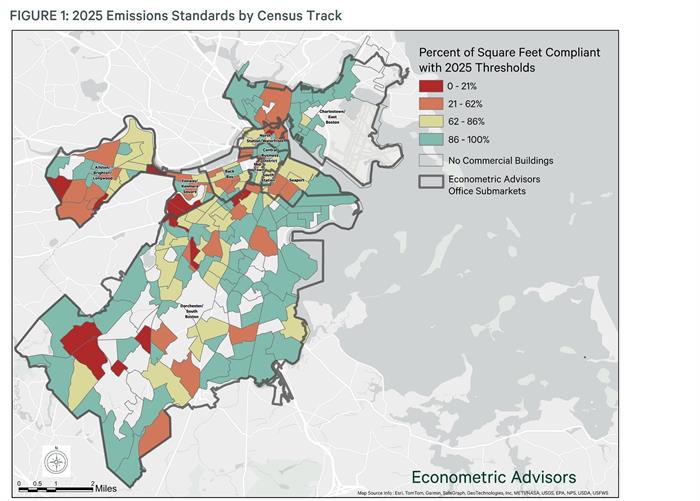/cbre_logo.png?sfvrsn=eac6e070_4)
Boston’s carbon neutrality challenge
Last August, CBRE Econometric Advisors identified 10 North American cities best positioned to withstand the impact of climate change. One of these is Boston, a city aiming to achieve carbon neutrality by 2050. With this goal in mind, the city enacted the Building Emissions Reduction and Disclosure Ordinance (BERDO) in 2021. This ordinance requires residential buildings with 35 units or more and commercial buildings of at least 35,000 sq. ft. to comply with emissions standards beginning in 2025. As part of its commitment to transparency, the city has been collecting and making publicly available building-level data.
After analyzing the 2023 data, we estimated that nearly 30% of commercial assets in Boston may fall short of their 2025 targets. Multifamily accounts for the most potential non-compliance due to their heavy reliance on natural gas and, to a lesser degree, heating oil. Many office assets, which typically rely on natural gas and district steam, are also at risk of non-compliance. To a smaller extent, hotel and laboratory assets are at risk as well. On average, non-compliant assets emit 7.7 kgCO2e/sq. ft./year of GHG (greenhouse gas) emissions, whereas emissions at compliant buildings are 3.7 kgCO2e/sq. ft./year.
Each of Boston’s 10 submarkets has non-compliant buildings. The central business district has the lowest percentage of non-compliant assets, largely attributed to the high concentration of LEED-certified buildings, accounting for around 19% of the office inventory. In contrast, suburban markets like Allston, Fenway and Dorchester, where educational, medical and older multifamily properties predominate, have the highest concentration of non-compliant assets.
Building retrofits is the best way to reach compliance targets. Transitioning from fossil fuel-based energy sources to cleaner alternatives can play a crucial role in reducing greenhouse gas emissions and maintaining a low Energy Use Intensity (EUI) rate.
*The data for this map has been taken from the City of Boston website; Building Emissions Reduction and Disclosure Ordinance (BERDO) - Dataset - Analyze Boston.

Sources:
1 https://www.boston.gov/environment-and-energy/reducing-emissions
3 https://www.energystar.gov/buildings/benchmark/understand_metrics/what_eui
What's Next?
Watch Now: 2024 Outlook WebinarAccess the recording of our latest quarterly webinar held Thursday, December 14. |
Locator DataViews Training Guide
Interested in learning more about our Locator tool? Access the training guide and learn how to best leverage the tool. |
CBRE Insights & Research
The places in which we live, work and invest will continue to change and adapt to technology, demographics and human expectations at an accelerated rate. |













